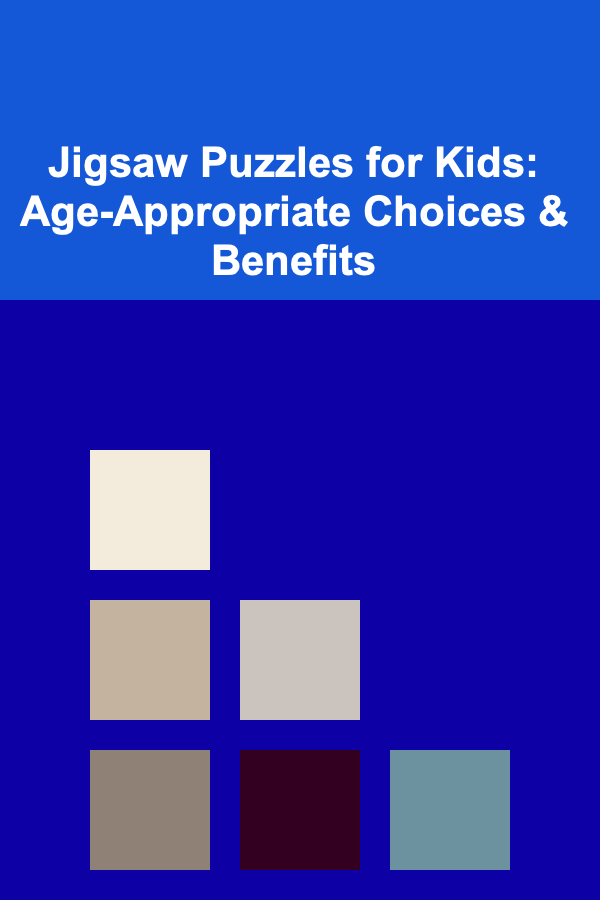
Jigsaw Puzzles for Kids: Age-Appropriate Choices & Benefits
ebook include PDF & Audio bundle (Micro Guide)
$12.99$5.99
Limited Time Offer! Order within the next:

Jigsaw puzzles have been a staple of childhood entertainment for generations, offering a fun and engaging way for kids to develop their cognitive, motor, and social skills. These puzzles provide children with a rewarding challenge that can keep them entertained for hours, all while offering numerous developmental benefits. However, with a wide variety of puzzle types and difficulty levels available, it's important for parents and caregivers to choose puzzles that are age-appropriate for their children. Understanding how puzzles contribute to a child's development can help parents make informed choices, ensuring that each puzzle provides the right balance of challenge and fun.
In this article, we will explore the benefits of jigsaw puzzles for kids, delve into age-appropriate puzzle choices, and offer tips for maximizing the developmental potential of puzzles for children at different stages.
The Developmental Benefits of Jigsaw Puzzles for Kids
Jigsaw puzzles do more than simply entertain children; they support the development of a wide range of skills that are essential for academic, social, and emotional growth. Below are some of the key developmental benefits of puzzles:
1. Cognitive Development
Jigsaw puzzles require children to think critically and problem-solve. By fitting pieces together, kids practice pattern recognition, spatial awareness, and memory. This helps build their cognitive abilities, particularly in the areas of reasoning, logic, and attention to detail.
- Problem-Solving Skills: Completing a puzzle involves figuring out which pieces fit together. This encourages logical thinking, as kids must deduce where each piece goes based on shape, color, and image alignment.
- Memory and Concentration: Remembering the placement of pieces and staying focused on the task at hand helps enhance a child's memory and ability to concentrate.
2. Fine Motor Skills
Handling the small puzzle pieces helps children develop their fine motor skills and hand-eye coordination. As they pick up, rotate, and place pieces, children strengthen their finger dexterity and improve their hand control, which are important skills for tasks such as writing, drawing, and using scissors.
- Grasping and Manipulating Pieces: Younger children learn how to grip and manipulate objects, improving their ability to grasp and release items.
- Eye-Hand Coordination: As kids position pieces in relation to the puzzle, they refine their eye-hand coordination.
3. Social Skills
When puzzles are completed in a group setting, they can foster collaboration and teamwork. Children can learn how to share ideas, communicate effectively, and work together toward a common goal.
- Cooperation and Turn-Taking: Working on a puzzle together encourages kids to take turns and share the task, which helps develop social skills like patience and respect for others.
- Communication: Talking through the puzzle-solving process encourages communication, as children explain their reasoning to others or ask for help when needed.
4. Emotional Development
Completing a puzzle gives children a sense of accomplishment, which can boost their confidence and self-esteem. The challenge of piecing together a picture also teaches persistence and patience as children work through difficulties and push themselves to finish.
- Building Patience: Puzzles often require extended periods of focus and effort, helping kids develop patience and the ability to manage frustration.
- Sense of Achievement: The moment when the last piece clicks into place brings a great sense of satisfaction and accomplishment, helping children understand the rewards of perseverance.
5. Creativity and Imagination
Puzzles often feature vibrant images, such as animals, landscapes, or famous characters, which can spark a child's imagination. As children engage with these images, they might create stories about what they see, further stimulating their creativity.
Age-Appropriate Jigsaw Puzzles for Kids
Jigsaw puzzles come in various difficulty levels, from simple puzzles for toddlers to more complex puzzles for older children. It's crucial to choose puzzles that are suitable for a child's developmental stage to avoid frustration and ensure that the puzzle offers an appropriate level of challenge.
1. Toddlers (Ages 1-3)
For toddlers, jigsaw puzzles should be simple and large enough to handle easily. At this stage, puzzles should focus on basic shapes, colors, and simple images to engage children's developing cognitive and motor skills.
- Puzzle Type: Large-piece puzzles with chunky pieces that are easy to grasp and fit together are ideal for toddlers. These puzzles often feature familiar objects like animals, everyday objects, or characters from popular children's TV shows.
- Material: Wooden puzzles or thick cardboard puzzles are the best choices for this age group, as they are durable and safe.
- Number of Pieces: Start with puzzles that have no more than 6-12 pieces. Puzzles with too many pieces can overwhelm toddlers and hinder their success.
Example Puzzles:
- Simple animal puzzles with big, colorful pieces.
- Puzzles with numbers or letters to help with early learning.
2. Preschoolers (Ages 3-5)
At this age, children are capable of handling more complex puzzles with slightly smaller pieces. Preschoolers can now focus on puzzles with more detailed images, such as farm animals, transportation, and nature scenes. Puzzles can also introduce the concept of fitting pieces based on patterns and colors.
- Puzzle Type: Puzzles with slightly smaller pieces (but still large enough to handle comfortably) are appropriate. Images can feature characters from fairy tales, vehicles, or nature scenes like forests, oceans, or farms.
- Material: Sturdy cardboard puzzles or foam puzzles are a good choice, as they are lightweight and easy to manipulate.
- Number of Pieces: Begin with puzzles containing 12-24 pieces. These puzzles should be challenging but achievable for a preschooler.
Example Puzzles:
- 12-24 piece puzzles featuring animals, transport vehicles, or favorite cartoon characters.
- Shape and color recognition puzzles.
3. Early Elementary (Ages 5-7)
At this stage, children's cognitive abilities are growing, and they can handle puzzles with more pieces and more detailed imagery. The challenge should start to involve different shapes and more complex scenes, as children's problem-solving skills are improving.
- Puzzle Type: Puzzles with scenes from nature, more complex animals, or basic scenes from daily life (such as a park or city street) are perfect for this age group. They can also handle puzzles that introduce themes like maps or simple patterns.
- Material: High-quality cardboard puzzles with thinner, more intricate pieces that are still easy to handle.
- Number of Pieces: Puzzles with 24-50 pieces are ideal, as they provide a good challenge without being frustrating.
Example Puzzles:
- 30-50 piece puzzles featuring more detailed scenes like a jungle or a cityscape.
- Puzzles based on popular movies, animals, or outer space.
4. Older Elementary (Ages 7-9)
At this stage, children can work on puzzles with more complexity, such as puzzles with 100-200 pieces. These puzzles might include more intricate images and introduce concepts such as symmetry and geometry. Kids in this age group are also capable of completing puzzles with more subtle details and a higher level of difficulty.
- Puzzle Type: Themed puzzles such as historical landmarks, famous works of art, or detailed cityscapes.
- Material: Standard cardboard puzzles with higher-quality pieces that can withstand frequent use.
- Number of Pieces: Puzzles with 100-200 pieces provide a challenge without being overwhelming.
Example Puzzles:
- 100-piece puzzles of famous landmarks, animals in their natural habitats, or detailed art scenes.
- Themed puzzles based on hobbies or interests (e.g., sports, space exploration, or fairy tales).
5. Tweens and Teens (Ages 9+)
As children grow older, they are capable of tackling complex puzzles with hundreds or even thousands of pieces. Puzzles at this age can feature intricate patterns, realistic images, or famous artwork. The level of detail and the sheer number of pieces can provide an exciting challenge for older kids.
- Puzzle Type: Puzzles featuring abstract patterns, detailed landscapes, or famous art pieces. Themes can range from nature to space exploration, or even complex 3D puzzles.
- Material: High-quality cardboard or wooden puzzles are ideal for this age group, as they provide durability for frequent assembly and disassembly.
- Number of Pieces: Puzzles with 500, 1,000, or more pieces are perfect for tweens and teens looking for a challenge.
Example Puzzles:
- 500-1,000-piece puzzles featuring iconic images, landscapes, or famous artwork.
- 3D puzzles or puzzles with geometric shapes and patterns.
Tips for Choosing the Right Puzzle for Your Child
While age recommendations for puzzles are generally helpful, each child develops at their own pace. Here are some tips for selecting the best jigsaw puzzle for your child:
- Consider Interests: Choose puzzles that align with your child's interests. Whether it's animals, space, or their favorite TV show, incorporating personal interests will keep them engaged and motivated to finish the puzzle.
- Check for Safety: Always ensure that the puzzle is age-appropriate in terms of size and material. For younger children, avoid puzzles with small pieces that could pose a choking hazard.
- Gradual Progression: Start with simpler puzzles and gradually increase the difficulty level as your child's skills improve. This will ensure that they don't become frustrated with puzzles that are too difficult.
- Make It Fun: Remember that puzzles should be fun! Encourage your child to enjoy the process rather than rushing to finish. Celebrate their accomplishments and help them when needed.
Conclusion
Jigsaw puzzles are an invaluable tool for supporting a child's development in multiple areas, from cognitive growth to fine motor skills and social interaction. By choosing age-appropriate puzzles, parents can ensure that their children are challenged and engaged in a way that fosters growth, while also having fun. Whether it's a simple wooden puzzle for a toddler or a complex 1,000-piece puzzle for a teenager, jigsaw puzzles provide endless opportunities for learning and enjoyment. By introducing these puzzles at the right time, parents can help nurture a child's love for problem-solving, creativity, and patience, all while fostering a sense of accomplishment with every piece they complete.
Reading More From Our Other Websites
- [Personal Investment 101] How to Understand and Use Index Funds for Long-Term Investment
- [Biking 101] The Ultimate Guide to Touring Bikes: What You Need to Know
- [Home Soundproofing 101] How to Soundproof a Bedroom for Better Privacy
- [Small Business 101] Essential Steps for Launching a Successful Startup Business in 2025
- [Home Cleaning 101] How to Clean a Bathroom Mirror: Get a Streak-Free Reflection
- [Home Renovating 101] How to Refinish Your Furniture During a Home Renovation
- [Home Pet Care 101] How to Recognize the Early Signs of a Pet Emergency That Requires Immediate Vet Care
- [Organization Tip 101] Why You Should Document Your Home Organization Journey
- [Personal Care Tips 101] How to Use Antiperspirant for Sweaty Hands and Feet
- [Home Rental Property 101] How to Make Your Rental Property Stand Out in a Competitive Market

How to Add a Blog to Your Website: A Simple Checklist
Read More
How to Celebrate Milestones Without Overspending
Read More
How to Keep Your Home Tidy with Minimal Daily Effort
Read More
How to Make Money Online as a Wine Reviewer: 10 Actionable Ideas
Read MoreHow to Provide Training on Expense Tracking and Reimbursement
Read More
How to Understand Baking Temperatures and Times
Read MoreOther Products

How to Add a Blog to Your Website: A Simple Checklist
Read More
How to Celebrate Milestones Without Overspending
Read More
How to Keep Your Home Tidy with Minimal Daily Effort
Read More
How to Make Money Online as a Wine Reviewer: 10 Actionable Ideas
Read MoreHow to Provide Training on Expense Tracking and Reimbursement
Read More